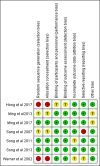Efficacy and reliability of active robotic-assisted total knee arthroplasty compared with conventional total knee arthroplasty: a systematic review and meta-analysis
- PMID: 30808721
- PMCID: PMC6585281
- DOI: 10.1136/postgradmedj-2018-136190
Efficacy and reliability of active robotic-assisted total knee arthroplasty compared with conventional total knee arthroplasty: a systematic review and meta-analysis
Abstract
Background: In the field of prosthetics, the ultimate goal is to improve the clinical outcome by using a technique that prolongs the longevity of prosthesis. Active robotic-assisted total knee arthroplasty (TKA) is one such technique that is capable of providing accurate implant position and restoring mechanical alignment. Although relevant studies have been carried out, the differences in the efficacy and reliability between active robotic-assisted TKA and conventional arthroplasty have not yet been adequately discussed.
Methods: We referenced articles, including randomised controlled trials and comparative retrospective research, from PubMed, Embase, Cochrane Library and Web of Science, in order to compare active robotic-assisted TKA with the conventional technique. Data extraction and quality assessment were conducted for each study. Statistical analysis was performed using Revman V. 5.3.
Results: Seven studies with a total of 517 knees undergoing TKA were included. Compared with conventional surgery, active robotic TKA showed better outcomes in precise mechanical alignment (mean difference, MD: - 0.82, 95% CI: -1.15 to - 0.49, p < 0.05) and implant position, with lower outliers (p < 0.05), better functional score (Western Ontario and McMaster University, Knee Society Score functional score) and less drainage (MD: - 293.28, 95% CI: - 417.77 to - 168.79, p < 0.05). No significant differences were observed when comparing the operation time, range of motion and complication rates.
Conclusion: The current research demonstrates that active robotic-assisted TKA surgeries are more capable of improving mechanical alignment and prosthesis implantation when compared with conventional surgery. Further studies are required to investigate the potential benefits and long-term clinical outcomes of active robotic-assisted TKA.
Keywords: active robotic-assisted; conventional; meta-analysis; systematic review; total knee arthroplasty.
© Author(s) (or their employer(s)) 2019. Re-use permitted under CC BY-NC. No commercial re-use. See rights and permissions. Published by BMJ.
Conflict of interest statement
Competing interests: None declared.
Figures






References
-
- HCPUnet, Healthcare Cost and Utilization Project Agency for healthcare research and quality. Available: http://hcupnet.ahrq.gov/ [Accessed 20 Dec 2012].
Publication types
MeSH terms
LinkOut - more resources
Full Text Sources
Medical

